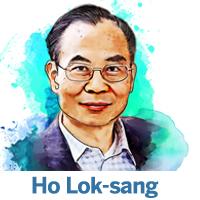The Chinese economy is not “stuck” in a “real economic crisis”, and its economic development model is not failing. The data speaks for itself. The Chinese economy grew by 5.2 percent last year. This compares with the United States’ 2.5 percent growth. This year, the Chinese economy in the first half grew by 5 percent year-on-year. This growth rate is again significantly faster than the US’. America’s first-quarter growth was an anemic 1.4 percent, while the second-quarter growth quickened to 2.8 percent.
 While China’s economy has indeed slowed down from its very high growth rate of 8 to 10 percent, which had been maintained for almost four decades, deceleration is not because its economic model is failing, but because of the containment policy of the West, led by the US; weakness in overseas markets, particularly Europe, Japan, and the United Kingdom; and a deliberate policy shift from emphasizing quantity of growth to quality of growth.
While China’s economy has indeed slowed down from its very high growth rate of 8 to 10 percent, which had been maintained for almost four decades, deceleration is not because its economic model is failing, but because of the containment policy of the West, led by the US; weakness in overseas markets, particularly Europe, Japan, and the United Kingdom; and a deliberate policy shift from emphasizing quantity of growth to quality of growth.
A popular criticism of China’s economic policy is “overcapacity”. The overcapacity narrative showed up again in a recent Foreign Affairs article by Zoe Liu, according to whom China has “a decades-old economic strategy that privileges industrial production over all else, an approach that, over time, has resulted in enormous structural overcapacity”. The author never presented any evidence of China offering lucrative privileges for industrial production to outperform competitors.
As far as I recall, there were indeed times when the economy was facing a serious downturn. During the collapse in overseas markets following the global financial tsunami of 2008, China did introduce a subsidy program called “jiadian xiaxiang” (electric home appliances going to the countryside) for households with a rural household registration to buy designated home appliances. But this is not an industrial policy to enhance Chinese producers’ competitiveness. China also subsidizes the purchase of electric vehicles. Authors Tong Zhang, Paul J Burke, and Qi Wang in an article published earlier this year in Resource and Energy Economics found that “purchase subsidies for domestic EVs have led to a sizeable increase in uptake”, and estimated that “increases in the per-vehicle subsidy rate have on average reduced carbon dioxide (CO2) emissions at a marginal subsidy cost of about 4,453 yuan ($620) per tonne, which is high. However other benefits, including long-run benefits from the emergence of a new clean technology sector, may be substantial”. The subsidy is necessary because China had committed to the peak carbon emissions goal by 2030 and carbon neutral emissions by 2060. China’s investment in the infrastructure needed for these goals is substantial. Economies of scale and innovations have allowed China to export EVs at affordable prices to many developing countries. What is wrong with that?
Regarding the deceleration of China’s total factor productivity (TFP): In this column last year, I argued that using macroeconomic data to estimate China’s TFP growth rate is problematic because while all capital input is registered in national income accounting data, only output that is recognized as part of the GDP will be counted as output. Using firm-level data, two scholars from Renmin University published an article in Applied Economics in 2021 saying that “the weighted TFP rises from 3.65 in 2007 to 4.69 in 2017, with an average growth rate of 2.58 percent”. Using firm level data will avoid the problem because capital input at the firm level will typically be used for market-related purposes. On the other hand, given the shift in emphasis from quantity of growth to quality of growth, after 2013 relatively more capital inputs are siphoned to non-market purposes such as poverty eradication, ecological preservation, environmental improvement, and healthcare.
Another problem with using macroeconomic data to measure economic growth has to do with microeconomics. Students in principle of economics courses all learn that it is indeed possible that total sales in monetary terms may decline when output rises because the consumers may require much lower prices in order to absorb all the output that is produced. GDP estimates based on the value of total sales would actually shrink even though real output has increased. Profits will then decline too. This is one explanation for the prevalence of the overcapacity narrative.
China operates a socialist market economy that looks beyond profit. With global warming representing an existential threat to humankind, investing in the green economy is certainly not just for profit. If we need to keep prices up so EVs and green energy stay highly profitable, we might avoid overcapacity but cannot survive climate change and the higher incidence of extreme weather that result. Surprisingly, the Foreign Affairs article says: “According to government statistics, 27 percent of Chinese automobile manufacturers were unprofitable in May; at one point last year, the figure reached 32 percent”. The author first says that Chinese EVs are cheap because they are heavily subsidized by the government. If that is the reason why Chinese EVs are cheap, they would not have been unprofitable.
Too many people misunderstand China and think that the West’s animosity against China is all because President Xi Jinping became assertive and departed from Deng Xiaoping’s “Hide and Bide” advice. This is totally mistaken. Peter Navarro and Greg Autry published their scary book Death by China in 2011, and that was well before President Xi took office. The elephant in the room is too big to miss.
The author is an adjunct research professor at the Pan Sutong Shanghai-Hong Kong Economic Policy Research Institute and the Economics Department, Lingnan University.
The views do not necessarily reflect those of China Daily.


